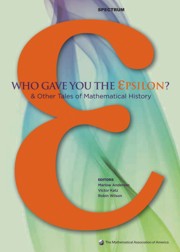Book contents
- Frontmatter
- Introduction
- Contents
- Analysis
- Geometry, Topology and Foundations
- Algebra and Number Theory
- Foreword
- Hamilton's Discovery of Quaternions
- Hamilton, Rodrigues, and the Quaternion Scandal
- Building an International Reputation: The Case of J. J. Sylvester (1814–1897)
- The Foundation Period in the History of Group Theory
- The Evolution of Group Theory: A Brief Survey
- The Search for Finite Simple Groups
- Genius and Biographers: The Fictionalization of Evariste Galois
- Hermann Grassmann and the Creation of Linear Algebra
- The Roots of Commutative Algebra in Algebraic Number Theory
- Eisenstein's Misunderstood Geometric Proof of the Quadratic Reciprocity Theorem
- Waring's Problem
- A History of the Prime Number Theorem
- A Hundred Years of Prime Numbers
- The Indian Mathematician Ramanujan
- Emmy Noether
- “ Marvelous Proof,”
- Afterword
- Surveys
- Index
- About the Editors
“ Marvelous Proof,”
from Algebra and Number Theory
- Frontmatter
- Introduction
- Contents
- Analysis
- Geometry, Topology and Foundations
- Algebra and Number Theory
- Foreword
- Hamilton's Discovery of Quaternions
- Hamilton, Rodrigues, and the Quaternion Scandal
- Building an International Reputation: The Case of J. J. Sylvester (1814–1897)
- The Foundation Period in the History of Group Theory
- The Evolution of Group Theory: A Brief Survey
- The Search for Finite Simple Groups
- Genius and Biographers: The Fictionalization of Evariste Galois
- Hermann Grassmann and the Creation of Linear Algebra
- The Roots of Commutative Algebra in Algebraic Number Theory
- Eisenstein's Misunderstood Geometric Proof of the Quadratic Reciprocity Theorem
- Waring's Problem
- A History of the Prime Number Theorem
- A Hundred Years of Prime Numbers
- The Indian Mathematician Ramanujan
- Emmy Noether
- “ Marvelous Proof,”
- Afterword
- Surveys
- Index
- About the Editors
Summary
No one really knows when it was that the story of what came to be known as “Fermat's Last Theorem” really started. Presumably it was sometime in the late 1630s that Pierre de Fermat made that famous inscription in the margin of Diophantus's Arithmetica claiming to have found “a marvelous proof”. It seems now, however, that the storymay be coming close to an end. In June 1993, Andrew Wiles announced that he could prove Fermat's assertion. Since then, difficulties seem to have arisen, but Wiles's strategy is fundamentally sound and may yet succeed.
The argument sketched by Wiles is an artful blend of various topics that have been, for years now, the focus of intensive research in number theory: elliptic curves, modular forms, and Galois representations. The goal of this article is to give mathematicians who are not specialists in the subject access to a general outline of the strategy proposed by Wiles. Of necessity, we concentrate largely on background material giving first a brief description of the relevant topics, and only afterwards describe how they come together and relate to Fermat's assertion. Readers who are mainly interested in the structure of the argument and who do not need or want too many details about the background concepts may want to skim through Section 2, then concentrate on Section 3. Our discussion includes a few historical remarks, but history is not our main intention, and therefore we only touch on a few highlights that are relevant to our goal of describing the main ideas in Wiles's attack on the problem.
- Type
- Chapter
- Information
- Who Gave You the Epsilon?And Other Tales of Mathematical History, pp. 360 - 374Publisher: Mathematical Association of AmericaPrint publication year: 2009

